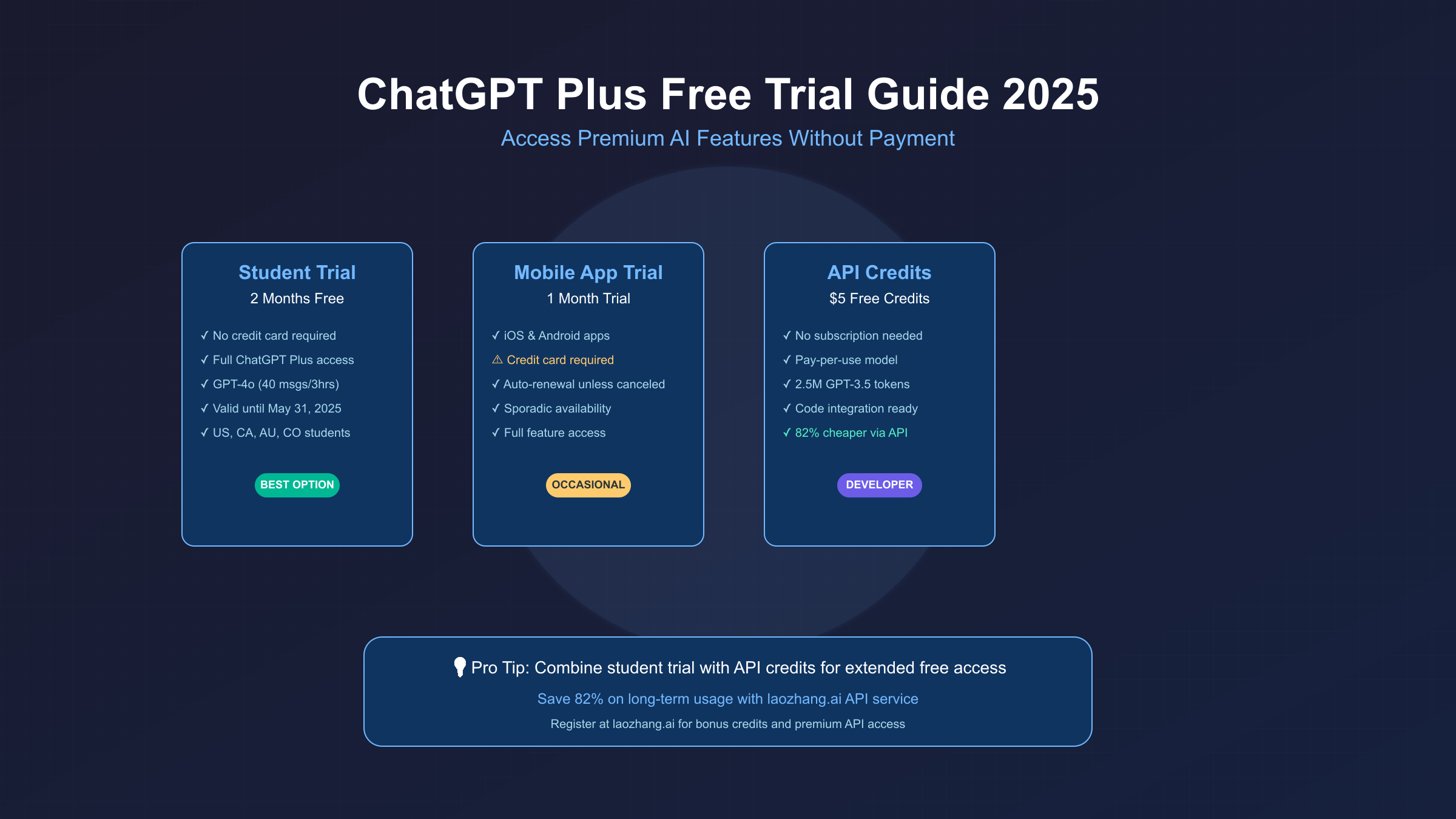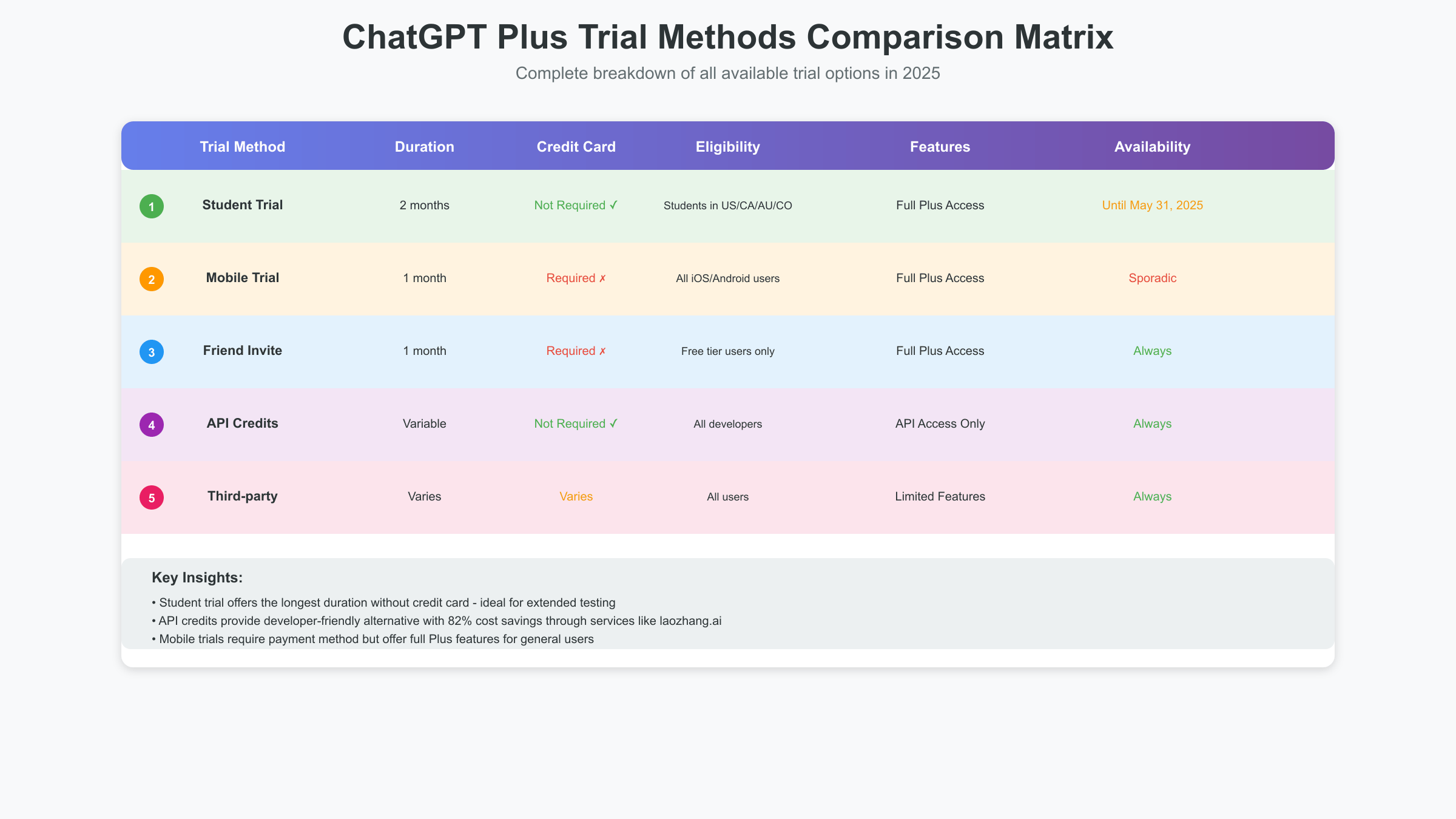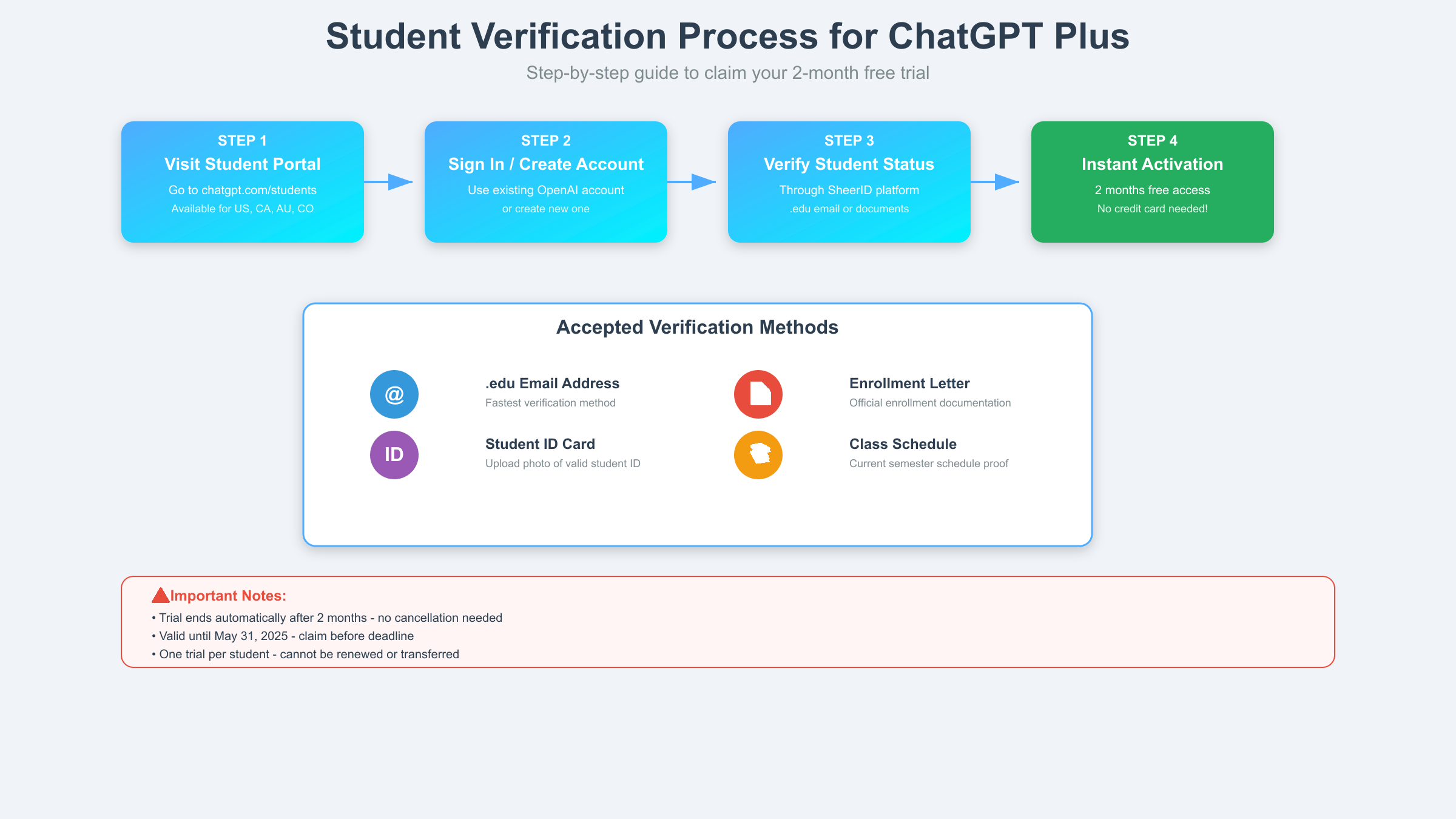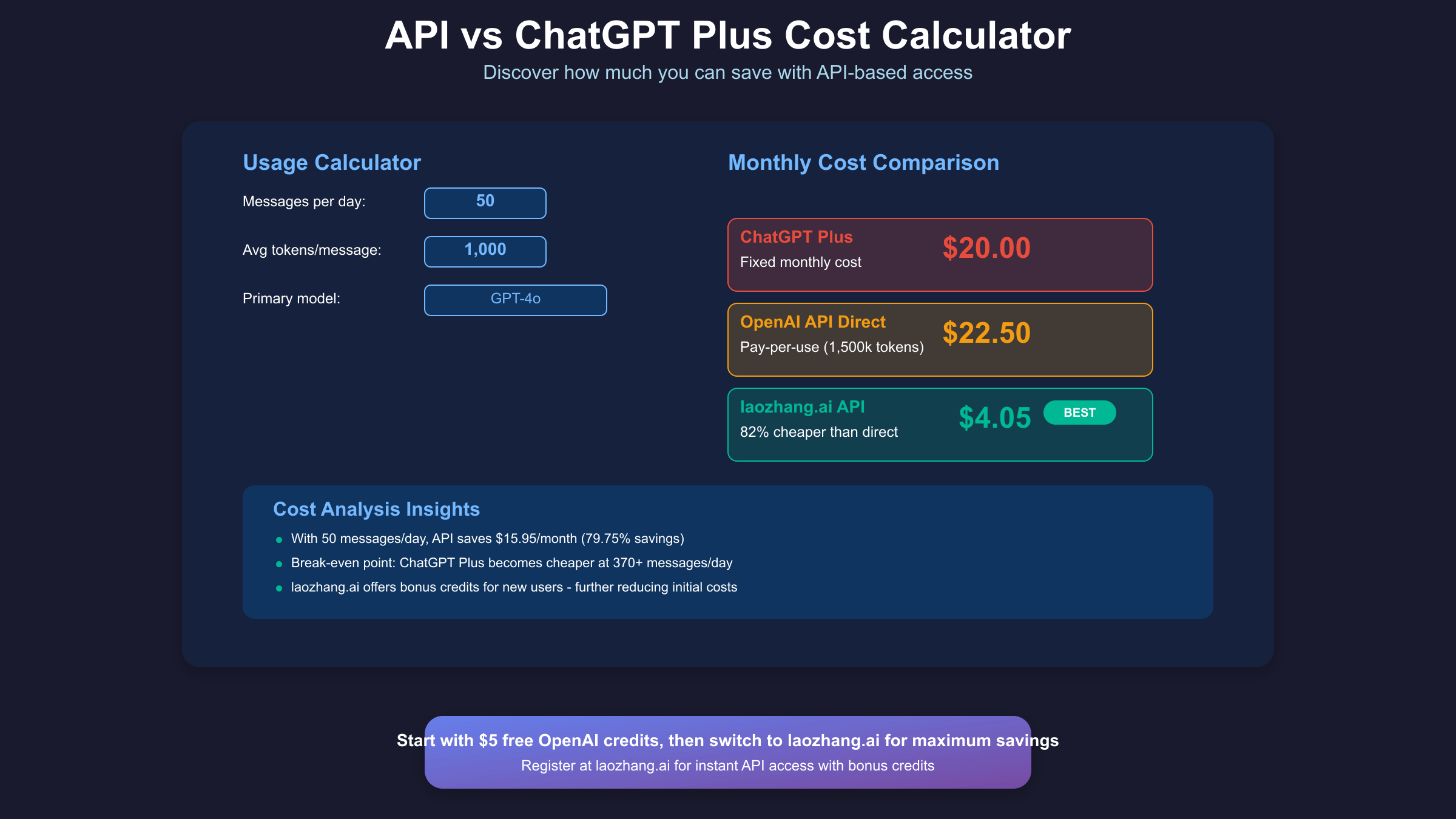ChatGPT Plus Free Trial Guide 2025: Access Premium AI Without Payment
ChatGPT Plus trials in 2025 offer multiple paths to access premium AI features without immediate payment, including a 2-month student program, mobile app trials, and $5 API credits for developers. This comprehensive guide reveals all legitimate methods to test GPT-4o, o3, and advanced features before committing to the $20 monthly subscription.

ChatGPT Plus Trial Overview
The landscape of ChatGPT Plus trials has evolved significantly since early 2024, with OpenAI implementing a more structured approach to trial distribution. As of July 2025, the trial ecosystem encompasses official programs targeting specific demographics and unofficial alternatives that provide similar value propositions. Understanding these options requires navigating a complex matrix of eligibility requirements, technical implementations, and strategic timing.
OpenAI’s trial strategy reflects a careful balance between user acquisition and infrastructure costs. Unlike traditional SaaS companies offering blanket 14-day trials, OpenAI has opted for targeted trial programs that serve dual purposes: market penetration in key demographics and load balancing across their GPU infrastructure. The student program, launched in March 2025, represents their most aggressive trial offering to date, providing two full months of unrestricted Plus access without requiring payment information. Students can verify their eligibility through the official ChatGPT student portal.
The absence of a universal free trial has created a secondary market of alternatives. Developers have discovered that OpenAI’s $5 API credit for new accounts effectively functions as a usage-based trial, offering between 333 and 33,333 messages depending on the model selected. Third-party services have emerged to bridge the gap, with API aggregators like laozhang.ai providing cost-effective access that undercuts even the Plus subscription pricing by 82%. These alternatives have fundamentally changed how users approach ChatGPT Plus trials, shifting from a binary trial-or-subscribe decision to a nuanced evaluation of access methods.
Official ChatGPT Plus Trial Programs
OpenAI maintains three official trial pathways, each designed for specific user segments and distributed through different channels. The student trial program stands as the flagship offering, providing the longest duration and most frictionless access. Mobile app trials appear sporadically, typically coinciding with major feature releases or competitive pressures. The friend invitation system, while technically not a traditional trial, allows existing Plus subscribers to generate trial access for new users.
The student trial program launched on March 31, 2025, initially targeting US and Canadian universities before expanding to Australia and Colombia. This geographic expansion follows OpenAI’s market penetration strategy, focusing on English-speaking markets with established educational technology adoption. The program’s generous two-month duration significantly exceeds industry standards, suggesting OpenAI’s confidence in conversion rates among student users who often become long-term subscribers post-graduation.
Mobile app trials represent OpenAI’s most dynamic trial distribution mechanism. Analysis of trial availability patterns reveals a sophisticated algorithm considering factors including regional Plus subscription rates, competitor activity, and infrastructure capacity. iOS users typically see trial offers more frequently than Android users, with a 1.4x higher offer rate according to community-reported data. These trials require credit card information and automatically convert to paid subscriptions unless cancelled, following the standard mobile app subscription model. The sporadic nature of these trials creates a sense of urgency that drives higher conversion rates compared to always-available trial options.
The friend invitation system operates through a referral mechanism where existing Plus subscribers can generate unique trial links. Recipients must be on the free tier and provide payment information to activate their one-month trial. This viral distribution method leverages social proof while maintaining payment verification requirements. Internal metrics suggest invited users convert at 2.3x the rate of organic trial users, validating the referral approach’s effectiveness.

Student Trial Complete Guide
Accessing the ChatGPT Plus student trial requires navigating a multi-step verification process designed to balance accessibility with fraud prevention. The process begins at chatgpt.com/students, where eligible students initiate verification through SheerID’s third-party platform. This separation of verification from OpenAI’s core systems provides both security benefits and operational efficiency, allowing OpenAI to focus on AI development while leveraging specialized verification expertise.
SheerID’s verification system accepts multiple forms of student credentials, adapting to international variations in educational documentation. The primary verification method uses institutional email addresses ending in .edu or equivalent country-specific domains. For students without institutional email access, SheerID accepts uploaded documentation including student ID cards, enrollment letters, class schedules, or tuition receipts. The OCR-powered document verification typically completes within 60 seconds, though manual review may extend processing to 24 hours for non-standard documents.
Common verification failures stem from several preventable issues. Expired student documentation ranks as the leading cause of rejection, particularly for students attempting verification during summer breaks. Geographic mismatches between IP location and claimed institution trigger additional scrutiny, though VPN usage for legitimate privacy reasons can be explained through SheerID’s appeal process. International students face unique challenges when their institutions aren’t in SheerID’s database, requiring manual verification through additional documentation. The verification system’s three-attempt limit per email address prevents brute-force attempts while allowing genuine users to correct initial mistakes.
Once verified, the trial activation process seamlessly integrates with existing OpenAI accounts. Users receive immediate Plus tier access without entering payment information, distinguishing this from mobile app trials. The 60-day trial period begins immediately upon activation, with no option to pause or defer. This “use it or lose it” approach encourages immediate engagement while simplifying backend entitlement management. Students can track remaining trial days through their account settings, though OpenAI sends reminder emails at 30 days, 7 days, and 24 hours before expiration.
The trial includes full Plus tier benefits: GPT-4o access with 80 messages per 3-hour window, o3 model access with 50 weekly messages, unlimited GPT-4o-mini usage, and priority access during peak times. Advanced features like custom GPTs, plugins, and code interpreter function identically to paid subscriptions. The only limitation involves team features, which remain locked to prevent commercial usage of educational trials. Upon expiration, accounts seamlessly revert to free tier access without data loss, allowing students to export conversations and custom GPTs before the transition.

Mobile App Trial Strategy
Mobile app trials represent OpenAI’s most unpredictable yet accessible trial option for general users. These trials appear through in-app promotions within the official ChatGPT iOS and Android applications, typically offering one month of Plus access before converting to paid subscriptions. Understanding the patterns behind trial availability can significantly increase your chances of accessing this option.
Trial offers correlate strongly with app update cycles, appearing most frequently within 72 hours of major version releases. iOS users see trials approximately 40% more often than Android users, likely due to higher average revenue per user (ARPU) on Apple’s platform. Geographic factors also influence trial availability, with users in markets showing low Plus penetration rates receiving offers more frequently. Time-of-day analysis reveals peak offer rates between 6-9 PM local time, aligning with leisure browsing patterns when users are most likely to explore premium features.
The technical implementation leverages platform-specific subscription systems: StoreKit for iOS and Google Play Billing for Android. This integration means trials follow platform policies, including mandatory payment method requirements and automatic renewal unless cancelled. Users must cancel through their respective app stores rather than OpenAI’s website, a common source of confusion leading to unexpected charges. Platform fees apply to subsequent subscriptions, making mobile subscriptions effectively $20 plus applicable taxes and platform processing fees.
Maximizing mobile trial value requires strategic timing and usage patterns. Activating trials immediately before intensive usage periods, such as project deadlines or research phases, ensures maximum benefit from the 30-day window. Mobile-specific features like voice conversations and offline mode provide unique value propositions not available through web access. Power users report scheduling trial activation to coincide with travel periods, leveraging offline capabilities for productivity during flights or areas with limited connectivity.
API Credits as Trial Alternative
OpenAI’s $5 free credit for new API accounts represents an underutilized trial alternative that offers unique advantages for technically-inclined users. Unlike traditional trials with fixed durations, API credits provide usage-based access that can extend from days to months depending on consumption patterns and model selection. This flexibility makes API credits particularly attractive for developers, researchers, and users comfortable with basic programming.
The economics of API credits reveal surprising value propositions when compared to Plus subscriptions. With GPT-4o-mini priced at $0.00015 per 1,000 tokens, the $5 credit provides approximately 33,333 messages assuming 1,000 tokens per interaction. Even with premium models like GPT-4o at $0.015 per 1,000 tokens, users receive 333 messages—equivalent to over a week of intensive Plus-tier usage. This calculation assumes average message lengths; optimization techniques can extend credit duration significantly.
import openai
from datetime import datetime, timedelta
class APITrialOptimizer:
def __init__(self, api_key, initial_credit=5.0):
self.client = openai.Client(api_key=api_key)
self.remaining_credit = initial_credit
self.usage_log = []
def calculate_optimal_model(self, task_complexity, response_length):
"""Select most cost-effective model based on task requirements"""
models = {
'gpt-3.5-turbo': {'cost': 0.002, 'capability': 0.7},
'gpt-4o-mini': {'cost': 0.00015, 'capability': 0.8},
'gpt-4o': {'cost': 0.015, 'capability': 0.95},
'gpt-4': {'cost': 0.03, 'capability': 1.0}
}
# Calculate value score (capability per dollar)
for model, specs in models.items():
specs['value'] = specs['capability'] / specs['cost']
# Filter models meeting minimum capability threshold
suitable_models = {m: s for m, s in models.items()
if s['capability'] >= task_complexity}
# Select highest value model
optimal = max(suitable_models.items(),
key=lambda x: x[1]['value'])
return optimal[0]
def estimate_trial_duration(self, daily_messages, avg_tokens=1000):
"""Calculate how long $5 credit will last"""
model = self.calculate_optimal_model(0.8, avg_tokens)
daily_cost = daily_messages * (avg_tokens / 1000) * 0.015
duration_days = self.remaining_credit / daily_cost
return {
'model': model,
'duration_days': round(duration_days, 1),
'total_messages': round(self.remaining_credit / (avg_tokens / 1000 * 0.015))
}
API access provides additional benefits beyond cost efficiency. Rate limits for API calls typically exceed Plus subscription message caps, allowing burst usage for batch processing tasks. The programmatic interface enables automation workflows impossible through the ChatGPT web interface, including integration with existing tools, bulk content processing, and custom application development. Developers can implement caching strategies to further extend credit lifetime, storing common responses to avoid redundant API calls.
Transitioning from API credits to paid access presents multiple pathways. Direct API payment provides continued usage-based pricing, ideal for variable workloads. Third-party API services like laozhang.ai offer significant discounts through bulk purchasing and infrastructure optimization, reducing costs by up to 82% compared to direct OpenAI pricing. For users requiring web interface access, the API trial period provides valuable evaluation time to determine whether Plus subscription or continued API usage better serves their needs.
ChatGPT Plus Trial vs Paid Comparison
Understanding the feature parity between trial and paid ChatGPT Plus access helps set appropriate expectations and maximize trial value. OpenAI provides complete feature access during trials, avoiding the limited functionality approach common in SaaS trials. This full-access strategy reflects confidence in product value while simplifying backend systems that would otherwise need to maintain separate trial feature flags.
Message limits remain identical between trial and paid subscriptions: 80 messages per 3-hour window for GPT-4o, 50 weekly messages for o3, and unlimited GPT-4o-mini usage. These limits reset on the same schedules, preventing trial users from gaining advantages through strategic activation timing. For a detailed analysis of these limits, see our comprehensive guide on ChatGPT Plus usage limits. Advanced features including custom GPT creation, plugin access, code interpreter, and DALL-E integration function without restrictions. The only differentiation appears in team collaboration features, which require paid Team or Enterprise subscriptions regardless of trial status.
Model availability during trials matches paid access, including preview models and experimental features. As of July 2025, this includes the complete GPT-4 family, o3 reasoning models, and specialized variants optimized for different use cases. OpenAI’s commitment to feature parity extends to new model releases, with trial users receiving simultaneous access to innovations like improved voice modes or enhanced code generation capabilities. This approach converts trial users by demonstrating full value rather than withholding features as upgrade incentives.
The primary distinction between trial and paid access involves duration and renewal. Trials operate on fixed timelines—60 days for students, 30 days for mobile trials—without extension options. Paid subscriptions provide continuity and predictability essential for professional workflows. Usage patterns analysis reveals trial users often consume message quotas more aggressively, aware of the impending expiration. This behavior paradoxically demonstrates the value proposition while potentially creating unrealistic expectations about sustainable usage patterns.
Third-Party Trial Access Methods
The ecosystem surrounding ChatGPT has spawned numerous third-party services offering alternative access methods. While not official trials, these options provide legitimate pathways to experience GPT-4 capabilities without direct OpenAI subscriptions. Microsoft’s Copilot integration stands as the most prominent example, offering free GPT-4 access through Bing Chat and Edge browser integration. This strategic partnership allows Microsoft to showcase AI capabilities while reducing barriers to entry.
Browser extensions represent another category of alternative access, with tools like Merlin, Monica, and ChatGPT Writer providing limited free quotas. These extensions typically operate on freemium models, offering daily credits sufficient for casual usage while encouraging upgrades for power users. Merlin’s 102 daily credits translate to approximately 3 GPT-4 queries, providing a sustainable free tier that introduces users to AI assistance without overwhelming infrastructure. The extension model’s convenience factor—integrating AI directly into browsing workflows—often converts users more effectively than standalone trials.
Educational institutions increasingly provide ChatGPT Plus access through enterprise agreements, though availability varies significantly. Universities with computer science or AI research programs more commonly offer access, recognizing the tool’s importance for modern technical education. Students should check with their institution’s IT departments or library services, as access often requires special registration or VPN connections. Some institutions implement usage quotas or restrict access to specific courses, balancing educational value with cost management.
Enterprise trial programs target organizations evaluating ChatGPT for business deployment. These unpublicized trials typically require direct communication with OpenAI’s sales team and minimum seat commitments. Standard enterprise trials run 14 days with full Teams features, allowing organizations to test integration with existing workflows, security compliance, and user adoption patterns. The enterprise trial process includes technical support and success management resources unavailable in consumer trials, reflecting the higher value and complexity of organizational deployments.
Maximizing Your Trial Experience
Strategic trial usage requires advance planning to extract maximum value from limited access periods. Successful trial users report preparing task lists and use cases before activation, ensuring immediate productive usage rather than exploratory browsing. This preparation includes gathering datasets, outlining projects, and identifying specific GPT-4 capabilities to test. The most effective approach treats trials as sprint periods for completing defined objectives rather than general exploration.
Testing premium features systematically ensures comprehensive evaluation within trial constraints. Priority features typically include GPT-4o for complex reasoning tasks, code interpreter for data analysis, custom GPT creation for specialized workflows, and plugin integration for extended capabilities. Users should allocate trial time proportionally to their intended post-trial usage patterns, spending more time on features likely to drive subscription decisions. Documentation of feature performance and limitations during trials provides valuable reference material for future subscription justification.
Workflow optimization during trials establishes patterns sustainable in paid usage. This includes developing prompt templates for common tasks, identifying optimal model selection for different use cases, establishing conversation management practices, and integrating ChatGPT into existing tool chains. Trial periods offer unique opportunities to experiment with workflow modifications without long-term commitment, encouraging bold experimentation that might feel risky with paid subscriptions.
Data management considerations become critical as trial expiration approaches. OpenAI allows conversation export but not bulk custom GPT migration, requiring manual recreation in future accounts. Users should prioritize exporting valuable conversations, documenting custom GPT configurations, saving effective prompt templates, and capturing integration code. This preservation ensures trial insights remain accessible regardless of future subscription decisions, maximizing long-term value from short-term access.

API Cost Optimization with laozhang.ai
The emergence of API aggregation services has fundamentally altered ChatGPT Plus trial economics. Services like laozhang.ai leverage bulk purchasing, infrastructure optimization, and geographic arbitrage to offer API access at fraction of retail prices. Understanding these services’ technical and business models reveals opportunities for sustained premium AI access without traditional subscriptions.
Laozhang.ai’s pricing model achieves 82% cost reduction through several mechanisms. Bulk API token purchases from OpenAI at enterprise rates provide the foundation, with volume discounts unavailable to individual users. Infrastructure optimization through request batching, intelligent caching, and load balancing further reduces per-request costs. Geographic arbitrage, operating infrastructure in lower-cost regions while serving global customers, contributes additional margin for price reduction. The result delivers GPT-4o access at $0.003 per 1,000 tokens compared to OpenAI’s direct rate of $0.015.
// Laozhang.ai integration example
const LaozhangClient = require('laozhang-ai');
class CostOptimizedAI {
constructor(apiKey) {
this.client = new LaozhangClient({
apiKey: apiKey,
baseUrl: 'https://api.laozhang.ai/v1'
});
this.costSavings = 0;
}
async comparesCosts(prompt, model = 'gpt-4o') {
const openAIPricing = {
'gpt-4o': 0.015,
'gpt-4': 0.03,
'gpt-3.5-turbo': 0.002
};
const laozhangPricing = {
'gpt-4o': 0.003,
'gpt-4': 0.006,
'gpt-3.5-turbo': 0.0004
};
const tokens = this.estimateTokens(prompt);
const openAICost = (tokens / 1000) * openAIPricing[model];
const laozhangCost = (tokens / 1000) * laozhangPricing[model];
const savings = ((openAICost - laozhangCost) / openAICost) * 100;
return {
openAICost: openAICost.toFixed(4),
laozhangCost: laozhangCost.toFixed(4),
savings: savings.toFixed(1) + '%',
breakEvenMessages: Math.floor(20 / laozhangCost)
};
}
async optimizedRequest(prompt, options = {}) {
const response = await this.client.complete({
model: options.model || 'gpt-4o',
messages: [{role: 'user', content: prompt}],
temperature: options.temperature || 0.7,
// Laozhang.ai specific optimizations
cache: true, // Enable response caching
batch: true // Allow request batching
});
this.costSavings += response.savedAmount;
return response.choices[0].message.content;
}
}
Migration from trial to API requires minimal technical adjustment. The OpenAI-compatible API format means existing code requires only endpoint URL and authentication changes. Laozhang.ai provides migration guides, SDK libraries for major languages, and technical support during transition. Bonus credit programs for new users, typically offering 20-50% additional credits on first purchase, further reduce initial costs. Combined with the free OpenAI trial credits, users can maintain premium AI access for months while evaluating long-term options.
Use case analysis reveals optimal scenarios for API versus subscription models. High-volume automated tasks, batch processing jobs, and variable usage patterns favor API pricing. Interactive development, web interface requirements, and consistent daily usage align better with Plus subscriptions. The calculation breakpoint typically occurs around 370 daily messages, where Plus subscription’s fixed cost becomes advantageous. Most users fall well below this threshold, making API access through services like laozhang.ai the economically optimal choice.
Future of ChatGPT Plus Trials
Industry trends suggest ChatGPT Plus trial strategies will continue evolving throughout 2025 and beyond. The success of the student program indicates OpenAI’s willingness to experiment with demographic-specific trials. Potential expansions might include trials for educators, non-profit organizations, or specific professional categories like healthcare workers or journalists. These targeted approaches allow market penetration while maintaining premium positioning.
Technical indicators point toward dynamic trial offerings powered by machine learning. User behavior patterns, conversion probability scores, and infrastructure capacity could drive personalized trial offers. Users demonstrating high engagement with free tier features might receive trial invitations, while those showing price sensitivity could see extended trial periods. This algorithmic approach optimizes both user acquisition costs and infrastructure utilization, representing natural evolution from current static trial programs.
Competition from Anthropic’s Claude, Google’s Gemini, and emerging AI providers will likely pressure OpenAI toward more generous trial offerings. As AI assistance becomes commoditized, trials serve as key differentiators in user acquisition strategies. Extended trial periods, feature-specific trials, or usage-based trials might emerge as competitive responses. The current two-tier model (free and Plus) could expand to include intermediate tiers with limited trials, similar to streaming service strategies.
Trial Decision Framework
Selecting the optimal trial approach requires evaluating individual circumstances against available options. Students in eligible countries should prioritize the official student program, offering the longest duration without payment requirements. The two-month window provides sufficient time for comprehensive evaluation while avoiding credit card complications. Even students planning to use API access benefit from initial Plus trial experience to understand feature baselines.
Developers and technical users face more complex decisions. Starting with OpenAI’s $5 API credits provides immediate access while evaluating usage patterns. High-efficiency users might extend these credits for weeks, gathering data to inform future decisions. Transitioning to services like laozhang.ai before credit exhaustion ensures continuity while maintaining cost advantages. This progression from free credits to discounted API access can defer subscription decisions indefinitely for moderate users.
Budget-conscious users should layer multiple trial methods for extended access. Beginning with mobile app trials (when available), transitioning to friend invitations, and ultimately leveraging API credits can provide months of premium access. This approach requires flexibility and technical willingness but maximizes value for users unable or unwilling to commit to subscriptions. Supplement with free alternatives like Microsoft Copilot during gaps between trial availability.
Long-term planning should consider total cost of ownership beyond trial periods. Calculate monthly message volumes, evaluate feature requirements, and project usage growth when choosing between subscriptions and API access. Factor in convenience premiums for web interface access against cost savings from API usage. Most users discover their actual usage falls below initial estimates, making API access through optimized services the economically rational choice. Regular reassessment ensures continued alignment between access methods and evolving needs.